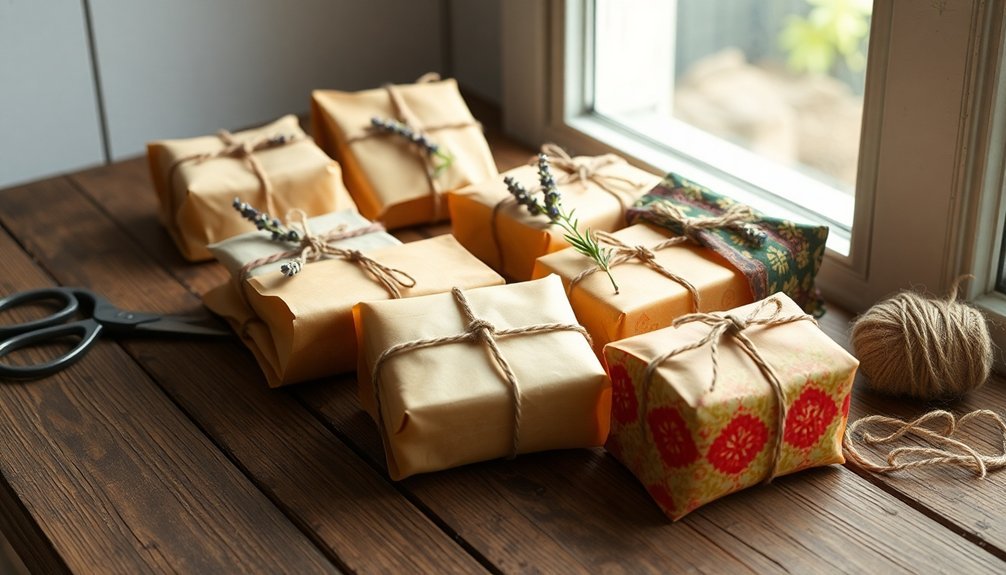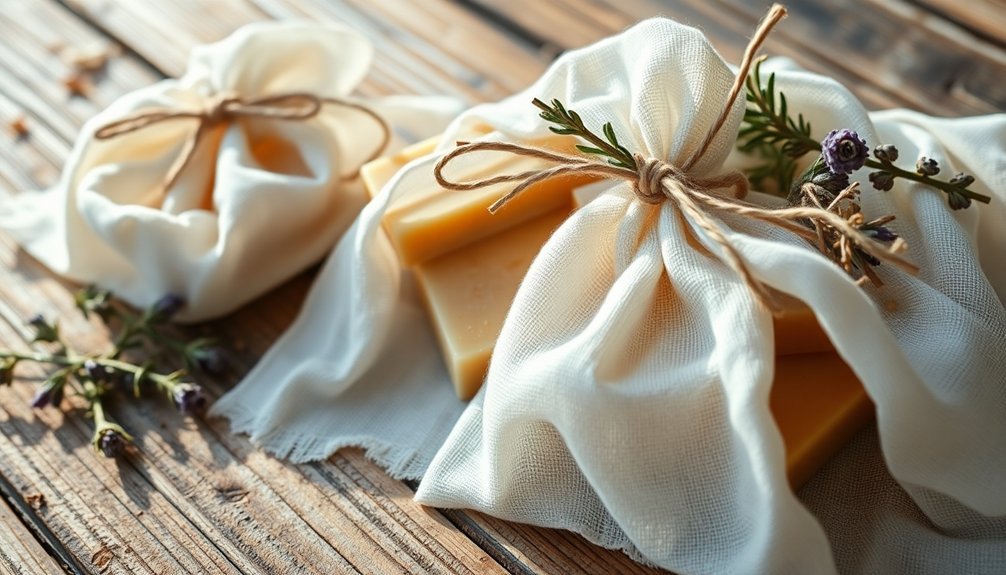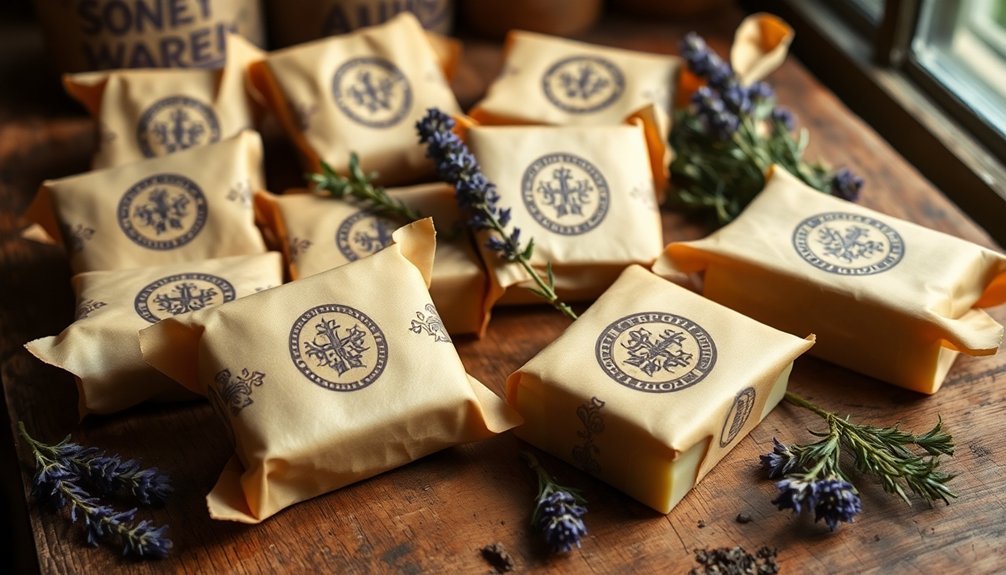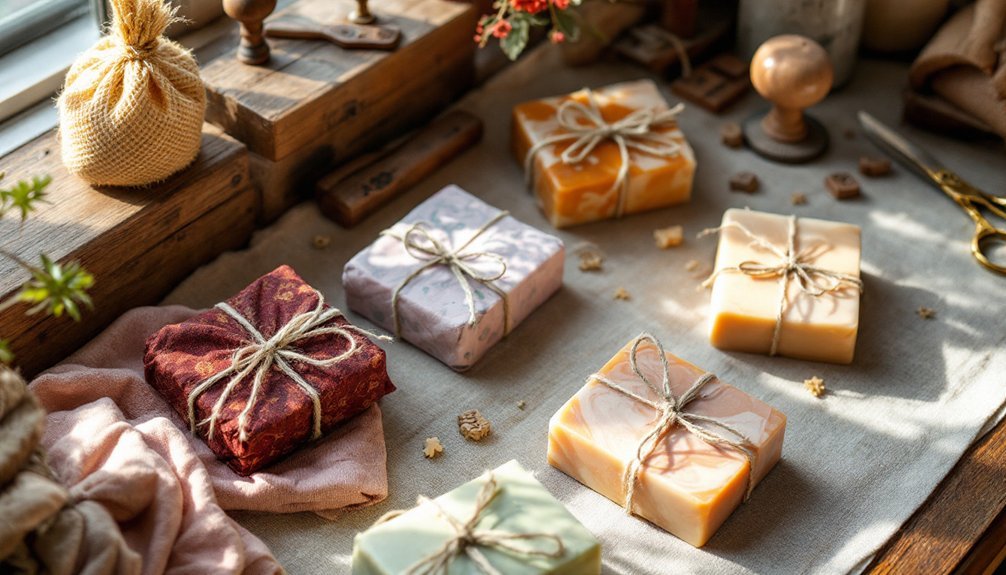Historic soap wrapping techniques offer both beauty and protection for your handmade creations. You can try the Victorian-era pillow paper fold for elegant symmetry, breathable muslin sachets from colonial times, moisture-resistant beeswax-dipped linen wraps popular in the 18th century, or decorative hand-stamped parchment inspired by medieval apothecaries. Traditional kraft paper secured with natural twine provides a rustic, eco-friendly option. These authentic methods will transform your soaps into treasured gifts with stories to tell.
5 Historic Ways To Hand-Wrap Handmade Soaps

While handmade soaps themselves are treasures of craftsmanship, their presentation through traditional wrapping methods adds another layer of artistry.
Throughout history, artisans have used kraft paper for its rustic appeal and eco-friendly nature, often securing it with natural twine instead of modern adhesives.
You'll find that traditional soap wrapping emphasized both protection and beauty. Sturdy thick papers were used to shield soaps from moisture while allowing them to cure properly.
Craftspeople would cut precise paper sizes, ensuring tight wraps that wouldn't loosen during handling.
Before modern printing, craftspeople hand-decorated their wrappings using stamps or watercolors to signify the soap's ingredients or scent. The process was time-consuming but rewarding, typically taking five to thirty minutes depending on the complexity of decoration.
Muslin bags were popular alternatives, offering breathability particularly suited for cold-process soaps while maintaining that authentic, handcrafted aesthetic.
The Classic Pillow Paper Fold: A Victorian Tradition
Dating back to the elegant Victorian era, the classic pillow paper fold stands as one of soap-making's most enduring packaging techniques. You'll need quality kraft paper or cardstock, adhesive, and your dried soap bars to create this timeless look. This method showcases the rustic appearance of kraft paper, which naturally complements handmade soaps.
| Materials | Techniques | Considerations |
|---|---|---|
| Thick kraft paper | Begin with straight edge fold | Confirm soap is completely dry |
| Biodegradable adhesive | Position soap centrally | Store in moisture-free area |
| Optional decorations | Create overlapping layers | Choose gentle adhesives |
To create the perfect pillow fold, place your soap in the center of your paper, fold the sides over, and secure with eco-friendly adhesive. The result is a neat, symmetrical package that enhances your soap's artisanal appeal while providing practical protection. You can customize with twine or labels for a personalized touch.
Muslin Sachets: Colonial-Era Soap Protection

Muslin sachets represent another historical approach to soap preservation that emerged during colonial times. This lightweight cotton material provides the perfect breathable environment for handmade soaps, preventing moisture buildup while allowing your creations to age properly. This practice gained popularity when English soap making began in the 12th century, establishing traditions that would later influence colonial wrapping techniques.
Embrace tradition with muslin sachets—nature's perfect breathable packaging for artisanal soaps, just as colonial crafters discovered centuries ago.
You'll appreciate how these natural fiber wrappings protect your soaps from light degradation while adding rustic charm to your presentation.
Three ways to customize your muslin sachets:
- Apply custom logos using fabric stamps or stencils
- Add colorful designs with fabric paint or iron-on transfers
- Embellish with ribbons or bows for an elegant finishing touch
Unlike modern plastic wraps, these reusable bags reduce environmental waste while offering a practical and attractive packaging solution that's perfect for retail display or gift-giving.
Beeswax-Dipped Linen Wraps From the 18TH Century
Artisans of the 18th century pioneered an elegant solution for soap preservation by combining two natural materials: beeswax and linen.
Though historical texts don't explicitly reference soap wrapping, evidence suggests waxed cloth was widely used for preservation purposes during this period.
To recreate this technique, you'll need to coat linen with a balanced mixture of beeswax, jojoba oil, and spruce resin.
Iron the coated fabric between parchment sheets to guarantee even distribution. The resulting wrap creates a breathable yet protective barrier that prevents your handmade soaps from drying out too quickly.
The fabric thickness matters considerably—too thin won't provide adequate protection, while overly thick material won't conform properly around your soap. This echoes historical practices where cerecloth wrapping was employed to protect valuable items during transport and storage.
This method exemplifies the ingenious preservation techniques that emerged before modern packaging existed.
Hand-Stamped Parchment: Medieval Apothecary Styling

While beeswax-dipped linen represented practical preservation, medieval soap makers embraced a more artistic approach through hand-stamped parchment.
Made from stretched animal skins, parchment offered durability against moisture while providing an elegant canvas for apothecary styling. You'll find that hand-stamping with nature-inspired motifs or healing symbols transformed functional wrapping into an art form. The craft involved similar attention to detail as European papermaking, where careful techniques persisted throughout multiple centuries of production.
To create your own medieval-inspired soap wraps:
- Select quality parchment paper and cut to size, leaving enough to fully enclose your soap
- Use wooden or metal stamps with natural inks (berry or soot-based) to add designs and ingredient information
- Treat the finished wrap with a light application of natural oil or wax to enhance longevity while maintaining the parchment's authentic appearance
Frequently Asked Questions
How Long Will Soap Stay Fresh in Traditional Wrapping?
Your handmade soap will stay fresh for 6-12 months in traditional breathable wrappings like cotton muslin or wax paper. You'll maximize freshness by storing it in a cool, dry place away from direct sunlight.
Can Historic Wrapping Techniques Meet Modern Labeling Requirements?
Yes, you can adapt historic wrapping techniques to meet modern requirements by incorporating printed labels or stamps that include ingredients, weight, and safety information while maintaining the traditional aesthetic appeal.
Were Scented Wrappings Used Historically to Enhance Soap Appeal?
No, you won't find much historical evidence of scented wrappings for soaps. Historically, soap wrappings were practical rather than aromatic, using simple materials like cloth or paper primarily for protection during transport.
How Did Soap Packaging Differ Across Social Classes Historically?
You'd find wealthy people's soaps wrapped in fine papers or decorative boxes, while middle-class consumers received simpler wrappings. The poor often got minimal packaging or none at all due to cost constraints.
What Tools Were Originally Used for Creating Decorative Soap Wraps?
You'd find artisans using simple tools like wooden stamps, wax seals, copper plates for embossing, natural dyes, quills for drawing, and hand-carved printing blocks to create distinctive patterns on their soap wrappings.
In Summary
You've now discovered five timeless methods that'll transform your handmade soaps into historically authentic treasures. Whether you're choosing the Victorian paper fold, colonial muslin, 18th century beeswax-dipped linen, or medieval parchment, these techniques don't just protect your soap—they tell a story. Try one or combine several approaches to create your own unique presentation that honors soap-making's rich heritage while delighting recipients with your handcrafted care.





Leave a Reply